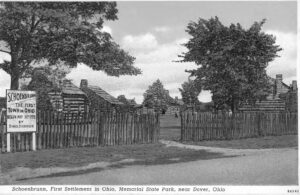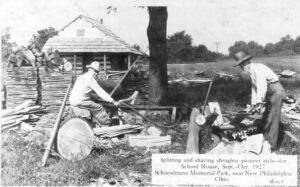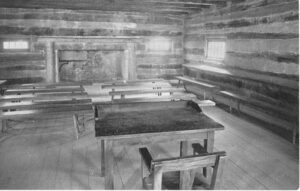Back to School in Pioneer Times

July 29th, 2022 marks the 249th anniversary of the first schoolhouse in the Ohio country. With the first day of school, quickly approaching, kids may appreciate seeing how school-aged children were educated in 1773. Visiting students will be transported to a world far from smartboards, laptops, and virtual learning.

Schoenbrunn Village is the site of several of Ohio firsts. These firsts include the site of the first settlement, church, schoolhouse and code of laws. The village has been restored to appear as it did more than two centuries ago. Visitors will see the original cemetery, reconstructed log structures, church, gardens and the schoolhouse.
Before going into the history of Schoenbrunn Village, I would like to take a moment to formally recognize that we are guests in the original homeland of the living nations of: The Miami Tribe, the Shawnee Tribe, the Eastern Shawnee Tribe, the Absentee Shawnee Tribe, the Delaware Nation, the Delaware Tribe, the Wyandotte Nation, the Seneca-Cayuga Tribe, the Seneca Nation, the Ottawa Tribe, Peoria Tribe, Pokagon Band Potawatomi, Forest County Potawatomi, Tonawanda Seneca, and others. I would like to extend our respect and gratitude to the many Indigenous people who call these lands home. It is important to recognize the role that Schoenbrunn played in 18th century tribal communities and the members of the Shawnee, Delaware, and Seneca-Cayuga (also historically known as the Mingo when living in Ohio) whose ancestors were forcibly removed from Ohio to Oklahoma.

In 1772, David Zeisberger, a missionary of the Moravian Church, established the village of Schoenbrunn (meaning “beautiful spring,” in German) on the Tuscarawas River, near present-day New Philadelphia. David Zeisberger, had found a rare pocket of neutrality in a region that was tense, as the American Revolution approached. The Moravians were eastern European Christian missionaries who sought to bring Christianity to Native Americans. One of their distinctions, from other missionary groups in North America, is the fact that all of the missionaries in the field learned the Native American’s language and taught in that language. There were limited educational opportunities in the Northwest Territory and Ohio, once it became a state. Mothers educated their children at home, although there were a number of schools founded in towns and villages.
Three years after building the schoolhouse, David Zeisberger published a spelling book for his Delaware pupils. In time Zeisberger translated the dictionary, sermons, hymn books and liturgies into the Delaware language. The school served Delaware Indian children, who were taught from special textbooks prepared in the Delaware and German languages, by Zeisberger. John Heckewelder, who taught at the school, is recognized as the first schoolteacher in Tuscarawas County. The present reconstructed schoolhouse was dedicated on July 29, 1928 on the 155th anniversary of the completion of the school’s construction.

Schoenbrunn was abandoned in 1777, after the start of the Revolutionary War. Today the site is maintained as Schoenbrunn Village State Memorial. This is a living history museum with many activities in the reconstructed village such as the annual Schoenbrunn Village Fair.
If you are looking for a fun summer activity, consider visiting one Ohio History Connection’s historical sites. If you can’t make the journey, in-person, be sure to check out Ohio Memory’s digital collection, for a virtual tour of the grounds and schoolhouse.
Thank you to Aimee Truitt, Catalog & Metadata Coordinator at the Ohio History Connection, for this week’s post!



Leave a Reply
You must be logged in to post a comment.